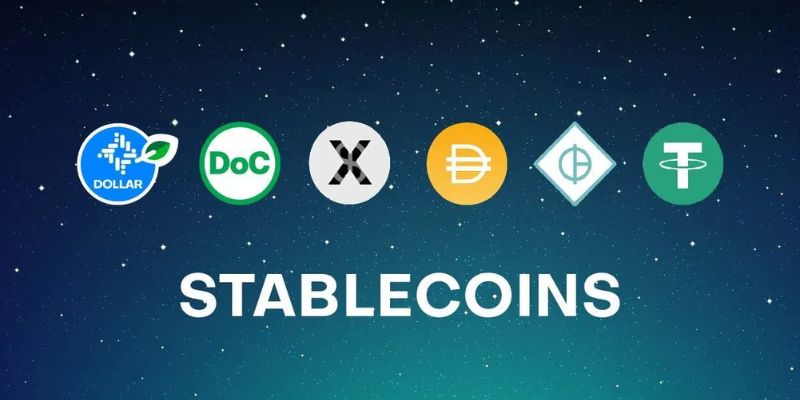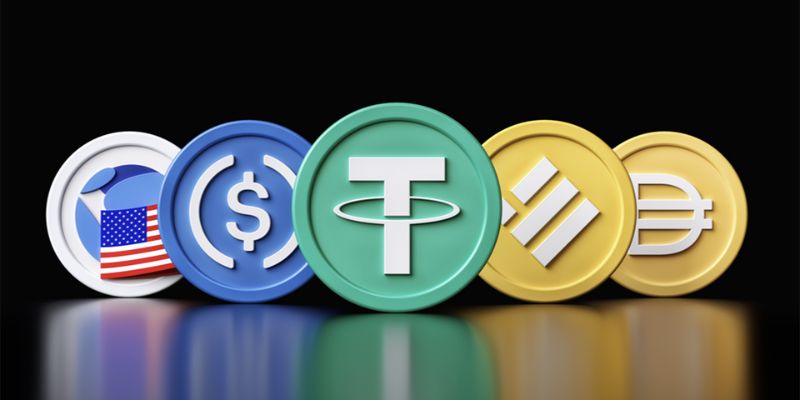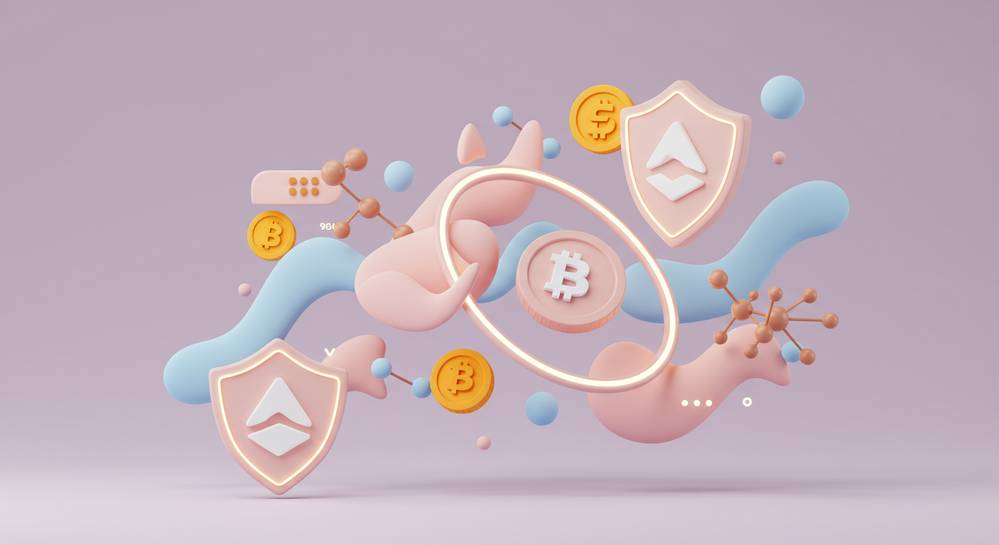I hear you asking, “What is a stablecoin?” It’s a buzzword tossed around in every crypto convo. Let’s strip it down to basics. While Bitcoin makes the news for its roller coaster prices, stablecoins chill out. They’re the cool-headed buddy in the volatile crypto gang. Think of them as the steady eddies, pegged to stuff like dollars or gold to keep their cool. In this digital currency showdown, stablecoins are the unsung heroes, hooking us up with stability in a world where crypto can be a wild ride. They’re the bridge between old-school cash and the new frontier of money. Buckle up, we’re about to decode this crypto riddle together.
The Foundation of Stablecoins: Understanding the Basics
Decoding Stablecoin Definition and Price Stability
What is a stablecoin? At its core, a stablecoin is digital money that tries to offer price stability. This stability is possible because a stablecoin’s value is attached to a basket of goods. These goods can be regular money (like dollars or euros) or other assets like gold. Think of stablecoins as a bridge between the fast-moving digital world and the slower, steady world of traditional money.
People use stablecoins because they don’t change in value like other cryptocurrencies can. A famous stablecoin, Tether ($USDT), often trades for about one US dollar. It can do this because for every Tether, there is one dollar being kept to back it up.
Comparing Stablecoin vs Cryptocurrency: A Contrast in Volatility
So, how are stablecoins different from typical cryptocurrencies such as Bitcoin or Ethereum? The biggest difference is how their values change. Imagine you have a bouncy ball and a rock. Cryptocurrencies, like the bouncy ball, can jump high or fall fast in value. It’s what makes them risky and exciting.
On the other hand, stablecoins are like the rock. They are steady and don’t move much in price. They do this by being tied, or pegged, to something stable. Fiat-collateralized stablecoins are pegged to real-world money. It’s like having digital dollars in your online wallet.
Crypto-collateralized stablecoins are interesting too. They use other cryptocurrencies to keep the value even. It’s a bit like making a castle out of LEGO; the final shape is stable because of how the pieces interlock.
Then there are non-collateralized stablecoins. These don’t have a pile of money or gold behind them but work more like an arcade ticket system that adjusts the number of tickets based on the number of players.
For anyone looking to jump into the crypto pool without the high dive of volatility, stablecoins offer a way to wade in calmly. They let you send, save, or spend without the usual roller coaster of prices. That’s why so many people find them useful, especially when they want to move money around the globe or pay for things online.
In the bustling market of digital currencies, stablecoins stand out. They are tools that can make everyone’s life easier, not just the tech-savvy or the bold investors. They’re a fascinating mix of the old and the new, a simple idea that might just help shape the future of money.

The Different Flavors of Stablecoins: Types and Examples
A Dive into Fiat-Collateralized Giants: USDT and USDC
Let’s talk stablecoins, the steady folks in crypto’s wild town. Imagine keeping money safe in a vault. That’s what fiat-collateralized stablecoins do. They lock up real world money like dollars to back each stablecoin. Easy, right? Let’s look at two big names: Tether ($USDT) and USD Coin ($USDC).
Tether, or $USDT, is like a promise. For every $USDT, there’s a dollar somewhere, saying “I got you.” That’s how they keep their value. They’ve got dollars in reserve, so one $USDT aims to always be one dollar.
USD Coin, or $USDC, plays the same game. Backed by dollars, one $USDC also wants to mirror one dollar. Both Tether and USD Coin are big players, holding lots of these real dollars. These giants lead the pack in how stablecoins maintain value.
Exploring Crypto-Collateralized and Non-Collateralized Options: Dai and Beyond
Stablecoins can also get backing from other cryptos. We call these crypto-collateralized stablecoins. The idea here is to use other crypto money as a safety net for stablecoins. This group includes Dai ($DAI), a neat example.
Dai stands out in the crowd. It’s backed by another crypto, Ethereum. Yes, it’s like crypto holding hands with crypto to stay stable. $DAI tries to keep its one dollar value, even if Ethereum’s price dances up and down.
But what if there’s no money in the vault? Enter non-collateralized stablecoins. They are the wild cards using smart tech to keep their cool. They don’t have money or crypto backing them up. Instead, they use algorithms, rules written in code, to keep their price steady.
Stablecoins aren’t just a one-trick pony. From giants like $USDT and $USDC to Dai and even those without a vault, they’re changing how we think about money. They give us options, and who doesn’t like options? We use stablecoins for payments, to trade, and as a safe harbor when other cryptos go on a roller coaster ride.
Understanding the secrets of stablecoins lets us see the big picture. It shows us why having a mix of these types matters. And why it pays to know how they work. Stablecoins take us one step closer to a world where money knows no bounds. Whether it’s making payments easier or shaking hands with other currencies, they’re here to stay. Welcome to the diverse world of stablecoins – where stability is the name of the game, no matter the flavor!

Navigating the World of Stablecoins: Usage, Legality, and Regulation
Stablecoins in the Marketplace: From Trading to Payments
Stablecoins are changing money. People like them because they are steady. They stick close to real money’s value, like dollars or euros. Imagine you have a friend, Joe. Joe wants a smooth trade or to send cash without the crazy ups and downs of regular crypto. Joe picks stablecoins. They work like magic. Money gets where it needs to, fast and without much cost. Shops start saying yes to stablecoins for coffee or books. Folks use them to keep their cash safe when they don’t trust their own country’s money.
Regulatory Challenges and Legal Frameworks Informing Adoption
Now, let’s talk rules. Stablecoins must play nice with the law. Big bosses at banks watch them closely. They want to make sure everything’s clear, that people can trust what’s going on. Some countries give a thumbs up. They like how stablecoins can help money move easily. Others are not so sure. They worry about people getting hurt. They think, “What if a stablecoin falls apart? Will folks lose their hard-earned cash?” So, they make tough rules to protect people. They ask questions about where the money backing stablecoins is, and if it’s safe. In the U.S., they’re working on new rules. They want stablecoins to be as safe as money in the bank. In some places, rules are already there, making sure stablecoins don’t cause trouble.
Now we know. Stablecoins are like sturdy ships in the wild sea of crypto. They help Joe trade and send cash without waves. But they need to follow the rules, and folks who make those rules are still figuring it all out. So, we keep an eye on it, learning and sailing along.
Risks, Rewards, and Future Projections: The Evolving Stablecoin Landscape
Assessing Stablecoin Advantages, Risks, and Market Capitalization
Stablecoins, they’re like money superheroes in the wild world of crypto. They hold their value strong, even when bad storms hit the markets. These special coins get their powers from different sources: some are backed by everyday money (those are fiat-collateralized), others by a bunch of cryptos (crypto-collateralized), and a bold new type doesn’t rely on backing at all (non-collateralized).
Now, let’s talk about the ups and downs of these steady Eddies. They’re great for paying folks quick and trading without seeing your cash value dance like crazy. Super neat stuff! But, ah, there’s a twist. Risks lurk around, like what happens if the backing goes kaput or someone gets sneaky with the funds? Market cap? That’s just how much all these stablecoins are worth put together.

The Rise of Central Bank Digital Currencies and Algorithmic Stablecoins
Guess what? Big banks are seeing these crypto champs and want in. They’re cooking up their own digital goodies called CBDCs. These bank wonders could change how we buy stuff and send money around.
But there’s even more superhero tech in the stablecoin world. Say hello to the algos, or algorithmic stablecoins. They’re like magicians using smart tricks to keep their value. No need for a pile of cash or crypto backup. It’s all in the algos. But watch out, one wrong spell and poof, there might be trouble.
So here’s the big question: Can we trust ’em, and can they stick around? There’s lots of chin-scratching over that. More rules might come, and we’ve got to keep our eyes peeled for how they’ll last. But one thing’s sure: folks are curious, and they’re using stablecoins more every day.
Whoa, don’t forget, with big power comes big responsibility. We need to be smarty-pants about where we put our trust, and be sure to peek at the fine print. Let’s keep learning and watching these crypto heroes soar, dive, and maybe even change the moolah game forever!
In this post, we’ve covered stablecoins from the bottom up. We started with the basics, looking at how stablecoins are different from other cryptocurrencies and why their prices don’t jump around as much. We then moved on to explore the big players like USDT and USDC, as well as other kinds like Dai. You’ve learned how these digital dollars work in the real world, from buying stuff online to how the law sees them. Lastly, we talked about the good and the bad that comes with stablecoins and peeked into what’s coming next with digital money from banks and clever stablecoins that run on their own.
What’s clear is stablecoins are a huge part of how we’ll use money in the future. They offer many chances but come with risks we can’t ignore. Stay smart, stay safe, and keep an eye on this space as it keeps changing.
Q&A :
What exactly is a stablecoin in cryptocurrency?
Stablecoins are a type of cryptocurrency designed to minimize price volatility by anchoring or pegging their value to a stable asset, commonly fiat currencies like the US dollar, Euro, or commodities such as gold. This stable asset serves as a reserve to back the value of the stablecoin, ensuring greater price consistency compared to other cryptocurrencies such as Bitcoin or Ethereum.
How do stablecoins maintain their stability?
Stablecoins maintain their stability through various mechanisms, depending on their type. Fiat-collateralized stablecoins keep a reserve of a fiat currency to back each token issued. Crypto-collateralized stablecoins use other cryptocurrencies as collateral but often require overcollateralization to account for volatility. Algorithmic stablecoins manipulate the supply of the token in response to changes in demand, aiming to maintain a stable price without a physical reserve.
Are stablecoins safe to invest in?
While stablecoins are generally considered less volatile and therefore “safer” in terms of investment stability compared to other cryptocurrencies, they are not without risk. The security of a stablecoin depends on the credibility of its reserves and the trustworthiness of its issuers. Regulatory, operational, and market risks can also affect their safety. Investors should do their due diligence and understand the specific mechanics and backing of any stablecoin they consider investing in.
Can stablecoins be used like regular money?
Stablecoins can indeed be used like regular money for many purposes, including online purchases, transfers, and as a stable store of value. Their value is designed to be stable relative to a fiat currency, making them a viable digital alternative to traditional money. However, mainstream adoption varies by region and regulatory environment, and not all merchants or financial systems may accept them as a form of payment.
What are the most popular stablecoins?
The most popular stablecoins tend to have significant market capitalization and are widely used within the cryptocurrency community. Some of the top stablecoins include Tether (USDT), USD Coin (USDC), Binance USD (BUSD), Dai (DAI), and TrueUSD (TUSD). These stablecoins have achieved popularity due to their relative stability, widespread acceptance, and the reputability of their issuing organizations.



